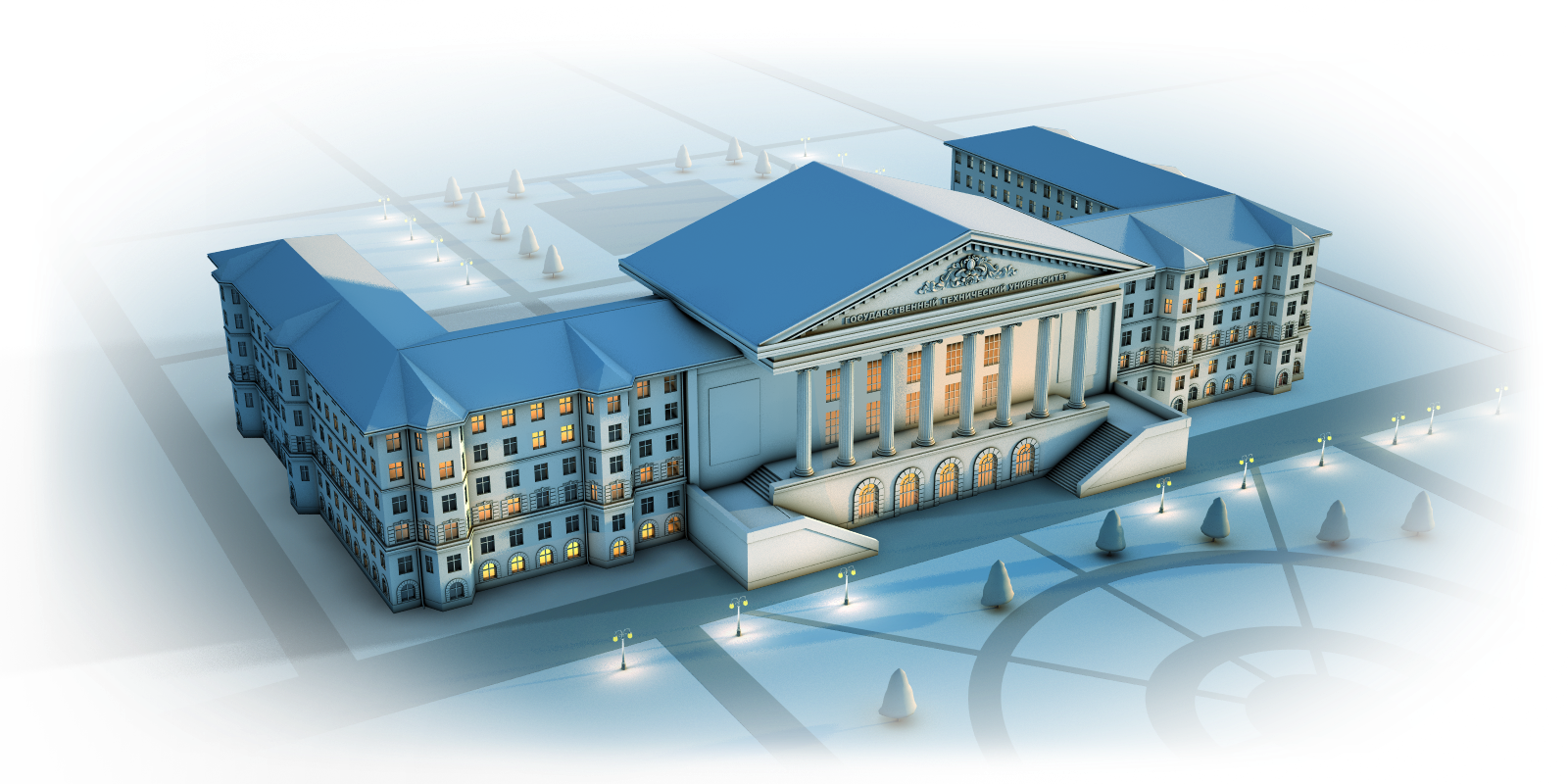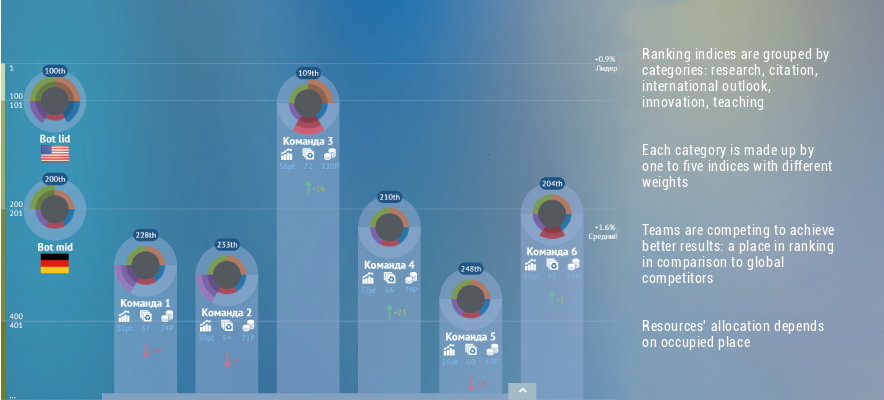Educational event features
Themes
-
International univesity rankings Ranking is comprised of 5 groups of indices. 13 values in total are measured: Citation index, Business income/corporate tax, Academic reputation, Students in total/corporate tax, University's Budget/corporate tax, PhD/corporate tax, Defenced bachelors/corporate tax, Research income/corporate tax, Published articles/corporate tax, Scientific reputation, Share of foreign teachers, International co-authorship.
-
Key aspects of the university activities Participants have to make decisions on the matter of such aspects of university's activities as: scientific and innovative activity, education, infrastructure and HR management, working with partner universities, marketing, international activity, management system, finances etc.
-
International university activities The international part of university's activities implies: an increase in citations as a result of publishing research articles in indexed journals, carrying out joint research projects, working with international foundations, invitations of foreign students and teachind staff and much more.
Participants
- Managerial employees of institutes and universities (heads of departments, their vices and common personnel).
- University's project teams' members, involved in carrying out various changes in universities.
Participation results
-
Implementation of university development programs Participants should come up with a university development plan, capable of putting them in top positions in world rankings. Within the confines of limited resources, players are supposed to detect breakthrough points and concentrate their attention and resources on these areas. The next step is to convert the plan into a number of decisions and projects, which can help the participants to achieve their goals.
-
University's economics management Investment resources of the university, which can be allocated for fulfilling a program, are limited. Because of this it is important to plan the resource consumption one step ahead, so that university won't end up being in a debt pit. Investment resource should be spent so that in the future university's incomes will be increased, not only expenses.
-
Implementation of a scientific research university model Rating used in the simulation assumes that, in order to get in the top position of world rankings, the team needs to develop a university following the model of a scientific research university. That implies development of a cutting-edge laboratories, research articles' promotion, searching for partners for joint scientific researches, invitation of people with high H-index etc.
-
Methods and techniques to work with international rankings Teams have to come up with method for ranking analysis and parsing of its structure, so that a sequence of steps, allowing for promotion of the university in that ranking could be developed, based on that analysis.
-
Teamwork Participants have to establish interaction and cooperation with each other so they can achieve mutual goals. They'll be presenting their own ideas, organise discussions inside teams, delegate functions etc.
-
Comprehensive view Players have a virtual unversity in their disposition, which is modeled with all the base management aspects and corresponding relations; external environment with international activities and influences is also being simulated. In such conditions the proccess of decision-making is made up of complicated interdisciplinary tasks, demanding the participants to figure out a complete picture of activities.
Formats
- Full-time staging for 1-2 days
- Integration in staff development courses
- Inclusion of simulator in retreats and discussions of university development strategies.
- Organisation of championships and olympiads
- Assessment tool
- Distant format of the game
Educational event features
Themes
Participation results
-
International univesity rankings Ranking is comprised of 5 groups of indices. 13 values in total are measured: Citation index, Business income/corporate tax, Academic reputation, Students in total/corporate tax, University's Budget/corporate tax, PhD/corporate tax, Defenced bachelors/corporate tax, Research income/corporate tax, Published articles/corporate tax, Scientific reputation, Share of foreign teachers, International co-authorship.
-
Key aspects of the university activities Participants have to make decisions on the matter of such aspects of university's activities as: scientific and innovative activity, education, infrastructure and HR management, working with partner universities, marketing, international activity, management system, finances etc.
-
International university activities The international part of university's activities implies: an increase in citations as a result of publishing research articles in indexed journals, carrying out joint research projects, working with international foundations, invitations of foreign students and teachind staff and much more.
-
Implementation of university development programs Participants should come up with a university development plan, capable of putting them in top positions in world rankings. Within the confines of limited resources, players are supposed to detect breakthrough points and concentrate their attention and resources on these areas. The next step is to convert the plan into a number of decisions and projects, which can help the participants to achieve their goals.
-
University's economics management Investment resources of the university, which can be allocated for fulfilling a program, are limited. Because of this it is important to plan the resource consumption one step ahead, so that university won't end up being in a debt pit. Investment resource should be spent so that in the future university's incomes will be increased, not only expenses.
-
Implementation of a scientific research university model Rating used in the simulation assumes that, in order to get in the top position of world rankings, the team needs to develop a university following the model of a scientific research university. That implies development of a cutting-edge laboratories, research articles' promotion, searching for partners for joint scientific researches, invitation of people with high H-index etc.
-
Methods and techniques to work with international rankings Teams have to come up with method for ranking analysis and parsing of its structure, so that a sequence of steps, allowing for promotion of the university in that ranking could be developed, based on that analysis.
-
Teamwork Participants have to establish interaction and cooperation with each other so they can achieve mutual goals. They'll be presenting their own ideas, organise discussions inside teams, delegate functions etc.
-
Comprehensive view Players have a virtual unversity in their disposition, which is modeled with all the base management aspects and corresponding relations; external environment with international activities and influences is also being simulated. In such conditions the proccess of decision-making is made up of complicated interdisciplinary tasks, demanding the participants to figure out a complete picture of activities.
Participants
Formats
-
- Managerial employees of institutes and universities (heads of departments, their vices and common personnel).
- University's project teams' members, involved in carrying out various changes in universities.
-
- Full-time staging for 1-2 days
- Integration in staff development courses
- Inclusion of simulator in retreats and discussions of university development strategies.
- Organisation of championships and olympiads
- Assessment tool
- Distant format of the game
Design of the simulator application
- Players will get to manage an average russian university, which isn't enlisted in tops of world rankings at the start of a game. They'll need to learn the starting attributes of the university: number of students and teaching staff, budger, degree of different research areas' development, educational programs' structures, development of international activities.About 5000 students and 500 teachers with 10 of them with high h-index82% consists of bachelor's degree programs8% - share of topical (modern, unique) educational programs6 research areas, with 4 of them being less developed~2,5 billion budget, ~72% budget incomes~3% of foreign students and teaching staff

- The foothold of the digital simulation is a virtual university with key aspects, local markets and resources as well as the international field.World rankingsIndexed journalsForeign staffPartner universitiesForeign university entrantsFaculty marketR&D marketLabour marketEntrants marketEducationScience and innovationsFinancesInfrastructureStaff
- Ranking consists of 5 groups of indices, which includes 13 indices. The goal is to get into top-100 ranks.
 Management tools in the simulator are grouped by indices of rankingInternational outlock 8%Citation 26,4%Innovation 37%Teaching 14%Research8%
Management tools in the simulator are grouped by indices of rankingInternational outlock 8%Citation 26,4%Innovation 37%Teaching 14%Research8% In order to successfully make changes to a virtual university and secure higher places in international rankings for it, a couple of aspects must be in the focus of a team:
Definition of the strategy of reaching top position in the rankingsBenchmarking and
competitors Team of participants
Team of participantsReach an agreement about the mutual viewpoint
Determine the action tactics
Resource allocation and decision-makingAnalysis of inner and outside situationsManagement decision-making- During the game in-game teams are compared to others by ranking indices groups and places achieved by teams in rankings.

- Event organisation is as follows:Game periodsYou'll be able to play for 5 rounds during the event1 round = 1 year of university's real-time activityTime dedicated to decision-making = from 1,5 to 0,3 hoursInternational team tasks: situation analysis and making presentations for plenary sessionsPlenary sessions: 3 sessions plannedGame roundAnalytics of management accountingGame decision-makingCalculation of the game roundResults analytics and analysisPresentation holdingPlenary session
Design of the simulator application
Main characteristics of the simulator
> 800
Participants successfully completed the simulation
18 — 36
People in a single league
> 8
Hours of tense activity
6
In-game teams
5 — 6
Game periods
> 250
Key decisions
~1000
Parameters in reports
13
Management aspects
19
Game interfaces
RU
Available languages
15
Games and events held
Main characteristics of the simulator
Usage in educational process
- Access to the simulator application
- Method materials (presentations with questionnaires etc)
- Materials needed for organisation and staging of the game (timetable, nameplates for tables, checklist for carrying out the game etc)
- Support by means of call-center, E-mail, Skype
- Access to the simulator application
- Method materials (presentations with questionnaires etc)
- Materials needed for organisation and staging of the game (timetable, nameplates for tables, checklist for carrying out the game etc)
- Support by means of call-center, E-mail, Skype
To the customers in need of new simulators
Our team has a trainer of the university management in new economic conditions. Accents in that simulation are more shifted to inner aspects of managing and competition between virtual universities.
Запрос') ?>
in university world rankings







